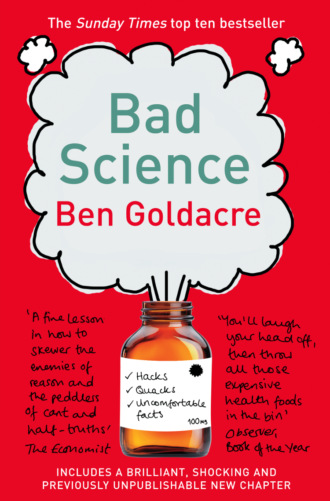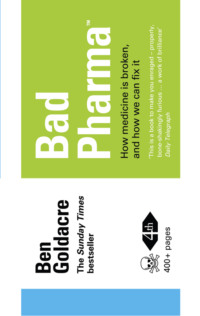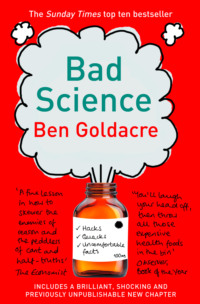
Полная версия
Bad Science
The creams in your local pharmacy seem to go way beyond this. They are filled with magic ingredients: Regenium XY technology, Nutrileum complex, RoC Retinol Correxion, Vita-Niacin, Covabeads, ATP Stimuline and Tenseur Peptidique Végétal. Surely you could never replicate that in your kitchen, or with creams that cost as much by the gallon as these ones cost for a squirt of the tiny tube? What are these magic ingredients? And what do they do?
There are basically three groups of ingredients in moisturising cream. Firstly there are powerful chemicals, like alpha-hydroxy acids, high levels of vitamin C, or molecular variations on the theme of vitamin A. These have genuinely been shown to make your skin seem more youthful, but they are only effective at such high concentrations, or high acidity levels, that the creams cause irritation, stinging, burning and redness. They were the great white hope in the 1990s, but now they’ve all had to be massively watered down by law, unless on prescription. No free lunch, and no effects without side-effects, as usual.
Companies still name them on the label, wallowing in the glory of their efficacy at higher potencies, because you don’t have to give the doses of your ingredients, only their ranked order. But these chemicals are usually in your cream at talismanic concentrations, for show only. The claims made on the various bottles and tubes are from the halcyon days of effective and high-potency acidic creams, but that’s hard to tell, because they are usually based on privately funded and published studies, done by the industry, and rarely available in their complete published forms, as a proper academic paper should be, so that you can check the working. Of course, forgetting that technical stuff, most of the ‘evidence’ quoted in cream adverts is from subjective reports, where ‘seven out of ten people who received free pots of cream were very pleased with the results’.
The second ingredient in almost all posh creams is one which does kind of work: cooked and mashed-up vegetable protein (hydrolysed X-microprotein nutricomplexes, Tenseur Peptidique Végétal, or whatever they’re calling them this month). These are long, soggy chains of amino acids, which swim around in the cream, languorously stretched out in the moistness of it all. When the cream dries on your face, these long, soggy chains contract and tighten: the slightly unpleasant taut sensation you get on your face when you wear these creams is from the protein chains contracting all over your skin, which temporarily shrinks your finer wrinkles. It is a fleeting but immediate pay-off from using the expensive creams, but it wouldn’t help you choose between them, since almost all of them contain mashed-up protein chains.
Finally there is the huge list of esoteric ingredients, tossed in on a prayer, with suggestive language elegantly woven around them in a way that allows you to believe that all kinds of claims are being made.
Classically, cosmetics companies will take highly theoretical, textbookish information about the way that cells work—the components at a molecular level, or the behaviour of cells in a glass dish—and then pretend it’s the same as the ultimate issue of whether something makes you look nice. ‘This molecular component,’ they say, with a flourish, ‘is crucial for collagen formation.’ And that will be perfectly true (along with many other amino acids which are used by your body to assemble protein in joints, skin, and everywhere else), but there is no reason to believe that anyone is deficient in it, or that smearing it on your face will make any difference to your appearance. In general, you don’t absorb things very well through your skin, because its purpose is to be relatively impermeable. When you sit in a bath of baked beans for charity you do not get fat, nor do you start farting.
Despite this, on any trip to the chemist (I recommend it) you can find a phenomenal array of magic ingredients on the market. Valmont Cellular DNA Complex is made from ‘specially treated salmon roe DNA’ (‘Unfortunately, smearing salmon on your face won’t have quite the same effect,’ said The Times in their review), but it’s spectacularly unlikely that DNA—a very large molecule indeed—would be absorbed by your skin, or indeed be any use for the synthetic activity happening in it, even if it was. You’re probably not short of the building blocks of DNA in your body. There’s a hell of a lot of it in there already.
Thinking it through, if salmon DNA was absorbed whole by your skin, then you would be absorbing alien, or rather fish, design blueprints into your cells—that is, the instructions for making fish cells, which might not be helpful for you as a human. It would also be a surprise if the DNA was digested into its constituent elements in your skin (your gut, though, is specifically adapted for digesting large molecules, using digestive enzymes which break them up into their constituent parts before absorption).
The simple theme running through all these products is that you can hoodwink your body, when in reality there are finely tuned ‘homeostatic’ mechanisms, huge, elaborate systems with feedback and measuring devices, constantly calibrating and recalibrating the amounts of various different chemical constituents being sent to different parts of your body. If anything, interfering with that system is likely to have the opposite of the simplistic effects claimed.
As the perfect example, there are huge numbers of creams (and other beauty treatments) claiming to deliver oxygen directly to your skin. Many of the creams contain peroxide, which, if you really want to persuade yourself of its efficacy, has a chemical formula of H2O2, and could fancifully be conceived of as water ‘with some extra oxygen’, although chemical formulae don’t really work that way—after all, a pile of rust is an iron bridge ‘with some extra oxygen’, and you wouldn’t imagine it would oxygenate your skin.
Even if we give them the benefit of the doubt and pretend that these treatments really will deliver oxygen to the surface of the skin, and that this will penetrate meaningfully into the cells, what good would that do? Your body is constantly monitoring the amount of blood and nutrients it’s supplying to tissues, and the quantity of tiny capillary arteries feeding a given area, and more vessels will grow towards areas with low oxygen, because that is a good index of whether more blood supply is needed. Even if the claim about oxygen in cream penetrating your tissues were true, your body would simply downregulate the supply of blood to that part of skin, scoring a homeostatic own goal. In reality, hydrogen peroxide is simply a corrosive chemical that gives you a light chemical burn at low strengths. This might explain that fresh, glowing feeling.
These details generalise to most of the claims made on packaging. Look closely at the label or advert, and you will routinely find that you are being played in an elaborate semantic game, with the complicity of the regulators: it’s rare to find an explicit claim, that rubbing this particular magic ingredient on your face will make you look better. The claim is made for the cream as a whole, and it is true for the cream as a whole, because as you now know, all moisturising creams—even a cheap litre tub of Diprobase—will moisturise.
Once you know this, shopping becomes marginally more interesting. The link between the magic ingredient and efficacy is made only in the customer’s mind, and reading through the manufacturer’s claims you can see that they have been carefully reviewed by a small army of consultants to ensure that the label is highly suggestive, but also—to the eye of an informed pedant—semantically and legally watertight. (If you want to make a living in this field, I would recommend the well-trodden career path: a spell in trading standards, advertising standards, or any other regulatory body, before going on to work as a consultant to industry.)
So what’s wrong with this kind of spin? We should be clear on one thing: I’m not on a consumer crusade. Just like the National Lottery, the cosmetics industry is playing on people’s dreams, and people are free to waste their money. I can very happily view posh cosmetics—and other forms of quackery—as a special, self-administered, voluntary tax on people who don’t understand science properly. I would also be the first to agree that people don’t buy expensive cosmetics simply because they have a belief in their efficacy, because it’s ‘a bit more complicated than that’: these are luxury goods, status items, and they are bought for all kinds of interesting reasons.
But it’s not entirely morally neutral. Firstly, the manufacturers of these products sell shortcuts to smokers and the obese; they sell the idea that a healthy body can be attained by using expensive potions, rather than simple old-fashioned exercise and eating your greens. This is a recurring theme throughout the world of bad science.
More than that, these adverts sell a dubious world view. They sell the idea that science is not about the delicate relationship between evidence and theory. They suggest, instead, with all the might of their international advertising budgets, their Microcellular Complexes, their Neutrillium XY, their Tenseur Peptidique Végétal and the rest, that science is about impenetrable nonsense involving equations, molecules, sciencey diagrams, sweeping didactic statements from authority figures in white coats, and that this sciencey-sounding stuff might just as well be made up, concocted, confabulated out of thin air, in order to make money. They sell the idea that science is incomprehensible, with all their might, and they sell this idea mainly to attractive young women, who are disappointingly underrepresented in the sciences.
In fact, they sell the world view of ‘Teen Talk Barbie’ from Mattel, who shipped with a sweet little voice circuit inside her so she could say things like, ‘Math class is tough!’, ‘I love shopping!’ and ‘Will we ever have enough clothes?’ when you pressed her buttons. In December 1992 the feminist direct-action Barbie Liberation Organization switched the voice circuits of hundreds of Teen Talk Barbies and GI Joe dolls in American shops. On Christmas Day Barbie said ‘Dead men tell no lies’ in a nice assertive voice, and the boys got soldiers under the tree telling them ‘Math class is tough!’ and asking ‘Wanna go shopping?’
The work of the BLO is not yet done.
Конец ознакомительного фрагмента.
Текст предоставлен ООО «ЛитРес».
Прочитайте эту книгу целиком, купив полную легальную версию на ЛитРес.
Безопасно оплатить книгу можно банковской картой Visa, MasterCard, Maestro, со счета мобильного телефона, с платежного терминала, в салоне МТС или Связной, через PayPal, WebMoney, Яндекс.Деньги, QIWI Кошелек, бонусными картами или другим удобным Вам способом.




